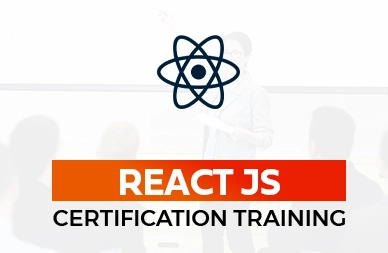Course Highlights and Why React JS Training in Pondicherry at FITA Academy?
Upcoming Batches
- 15-12-2025
- Weekdays
- Monday (Monday - Friday)
- 18-12-2025
- Weekdays
- Thursday (Monday - Friday)
- 20-12-2025
- Weekend
- Saturday (Saturday - Sunday)
- 22-12-2025
- Weekdays
- Monday (Monday - Friday)
Classroom Training
- Get trained by Industry Experts via Classroom Training at any of the FITA Academy branches near you
- Why Wait? Jump Start your Career by taking the React JS Training in Pondicherry!
Instructor-Led Live Online Training
- Take-up Instructor-led Live Online Training. Get the Recorded Videos of each session.
- Travelling is a Constraint? Jump Start your Career by taking the React JS Course Online!
React JS Course Objectives
- Learn how to configure the Node environment for TypeScript transpilation and comprehend the TypeScript framework and its benefits.
- Class design, object creation, properties, methods, constructors, inheritance, and access modifiers are all covered in this TypeScript exploration of object-oriented programming.
- Learning about React JS, its importance, features, and the single-page application (SPA) concept, emphasizing component-based architecture.
- To discover the fundamentals of React JS, including NPM, Webpack, selecting the appropriate IDE, using browsers and browser plugins, and comprehending React’s syntax.
- Learn about the JSX (JavaScript Extension), its format, renderer, attributes, comments, expressions, and event handling.
- Knowing the types, benefits, life cycle techniques, child components, and event management of React components.
- To gain knowledge about code conventions, debugging tools, ESLint, handling API requests, routing in React, and development techniques for effective development.
React JS Course Trainer Profile
- React JS Course in Pondicherry trainers are real-time professionals who offer students hands-on training and real-time projects.
- Through in-depth instruction, trainers develop students’ skill sets in the field of front-end application, focusing on industry standards.
- Each student receives the necessary individualised attention from mentors, who also provide extensive hands-on practice and in-depth learning of the React JS topics.
- React JS Training Institutes in Pondicherry instructors are experts in front-end applications.
- Trainers provide professional resume and mock interview training, equipping students with strategies to approach interviews confidently.
Learn at FITA Academy & Get Your
Dream IT Job in 60 Days
like these Successful Students!
Student Success Story of React JS Training in Pondicherry
Karthick had completed his degree two years ago but couldn’t start his career due to a major bike accident. He had to take rest for more than a year. After recovery, he felt he lost his confidence and didn’t know where to begin again.
One of his college seniors suggested FITA Academy and showed him the Google reviews and student success stories. After seeing the positive feedback and hearing real stories, Karthick decided to join the online React JS Training in Pondicherry.
After joining, he felt motivated again. His trainer explained every topic in a very simple way. The practical classes and real-time projects helped him learn quickly. He said the best part was that trainers cleared his doubts patiently.
FITA Academy’s placement team helped him prepare for interviews, arranged mock sessions, and sent his resume to top companies. After completing the course, he got placed at Tech Mahindra with a salary of ₹4.2 LPA.
Key Features
FITA Academy empowers individuals with industry-relevant skills through expert-led training, transforming careers with hands-on experience.

Expert Trainers
Learn from industry professionals with hands-on experience.

Real-Time Projects
Gain practical exposure by working on live projects.

Certification
Get certified from FITA Academy and become job-ready.

Affordable Fees
High-quality courses available at a low budget.

Flexible Learning
Choose online/classroom, timings, and learning pace.

Placement Support
Access 3000+ companies for career opportunities.
Why Learn React JS Training in Pondicherry at FITA Academy?
Live Capstone Projects
Real time Industry Experts as Trainers
Placement Support till you get your Dream Job offer!
Free Interview Clearing Workshops
Free Resume Preparation & Aptitude Workshops

React JS Certification Training in Pondicherry
Students who successfully finish the React JS course in Pondicherry are awarded a certificate of completion as evidence of their proficiency. By adding this certification to their resumes, students can highlight their newly acquired knowledge and skills, making them more marketable to hiring managers and employers, especially during interviews.
React JS Training Pondicherry from FITA Academy gives students access to a wide range of job options with the companies of their choice. Their abilities are validated by this qualification, which also provides a key to a wide range of opportunities in the ever-evolving tech sector.
Key Benefits of Learning React JS at FITA Academy in Pondicherry
- Expert Trainers: Gain knowledge from industry professionals with years of real-time experience in React JS frameworks.
- Flexible Batches: Choose from weekday and weekend batches that suit your schedule, making learning convenient and practical.
- Career Support: Receive 100% placement assistance, including resume building, mock interviews, and interview scheduling with top companies.
- Certification: Get a recognized React JS certification upon course completion, increasing your credibility in the job market.
- Affordable Fees: Our training is offered at a competitive price, making quality education accessible to everyone.
- Strong Placement Network: FITA Academy has tie-ups with 3,000+ companies, giving you access to a wide range of job opportunities.
Have Queries?
Talk to our Career Counselor for more Guidance on picking the right Career for you!
Placement Session & Job Opportunities
After completing React JS Training in Pondicherry




One of the most well-liked and effective JavaScript frameworks is React JS, which is used to create front-end and graphical user interfaces for websites. Due to its scalable and straightforward features, React JS has risen by leaps and bounds in recent years. It also enables the development team to produce parts that can function apart from one another and be reused. The learning curve is also pretty flat when comparing React JS to other JavaScript libraries. Top-tier businesses that use Facebook, AirBnB, Yahoo Mail, Netflix, and Whatsapp.
According to sources from renowned Indian employment portal websites, over 9000 React JS jobs are available on LinkedIn. React JS Developers are sought after by reputable organisations like Amazon, Accenture, Wipro, TCS, Directi, Cognizant, Infosys, and E&Y. In India, a fresher developer can expect to earn between Rs. 3,1,00,000 and Rs. 4,1,00,000 annually. With 2-4 years of expertise, developers may expect to make between Rs. 5,1,00,000 and Rs. 8,00,000 annually. React JS developers get an average yearly salary of $100741 worldwide. Under the direction of working professionals, FITA Academy’s React JS Training in Pondicherry gives students in-depth instruction in React JS ideas and applications, allowing them to develop the necessary professional skill sets for a React JS developer.
“After finishing the React JS course, students receive 100% placement support till they get their dream job.”
Job Roles
Front-End Developer
Front-end developers utilise technologies such as HTML, CSS, and JavaScript to design user interfaces and enhance user experiences. For creating dynamic and interactive web apps, mastery of React.js is highly valued. React JS Training Center in Pondicherry prepares students to be ready for a variety of positions in the React JS industry, including front-end developer.
JavaScript Developer
Being built on top of JavaScript, ReactJS can significantly enhance your proficiency as a JavaScript developer, enabling you to work on a various projects and produce high-quality applications. This is crucial, as the JavaScript Developer position holds a vital technical role in many software companies.
Full-Stack Developer
Full-stack developers handle the front-end and back-end components of programs. React.js is a powerful tool for front-end web application development, providing outstanding outcomes. Many different businesses have a high demand for full-stack developers. For anyone who wants to follow a profession in the React JS framework, FITA Academy’s React JS Training Pondicherry is a great place to start.
UI/UX Developer
User Interface (UI) and User Experience (UX) developers focus on creating aesthetically pleasing and user-focused applications. A helpful tool for turning designs into colourful, interactive elements and making them come to life in an appealing way is React.js. The React JS field has a significant demand for UI/UX specialists. After completing the training, FITA Academy successfully helped several students secure jobs as UI/UX developers.
Narayanan S
I had a great learning experience at FITA Academy's React JS Training in Pondicherry. My trainer was patient and dedicated, ensuring that each student thoroughly understood the concepts. The course curriculum was well-structured, covering all the essential topics of React JS. Thank you, FITA Academy.
Vincent A
I had a wonderful learning experience with FITA Academy. The course was comprehensive, and the practical assignments helped me gain confidence in building React applications. The friendly and supportive learning environment made the entire training journey enjoyable. I highly recommend FITA Academy for anyone looking to master React JS.
Haritha D
Joining FITA Academy for React JS Training in Pondicherry was a great experience. The practical approach of the training helped me grasp the concepts effectively. The institute provided excellent resources and support throughout the course. Thanks to FITA Academy, I am now proficient in React JS and confident in pursuing a career in web development.
Our Students Work at

Frequently Asked Question (FAQ) about React JS Training in Pondicherry
- Our React JS Course in Pondicherry is designed and delivered by React JS professionals who are renowned leaders in the web development industry.
- Over 1,00,000 students trained by FITA Academy.
- ReactJS Course fee structure has been designed to be reasonable for both students and working professionals.
- We provide flexible batch timings for both students and working professionals.
- We provide Interview tips and corporate training.
- We offer 100% placement support to help students secure their dream job.
- Yes, FITA Academy has a placement network with more than 3000 companies.
- The Placement cell provides students with various mock Interview practices, React JS interview questions and answers and group discussion training, enabling them to approach the interview with confidence.
Our ReactJS batch size has been limited to ensure all students receive necessary individualized attention when discussing challenging material with tutors. So, we maximum number of members for a React JS batch is 5–6 individuals.
Certainly, the React JS instructors at FITA Academy are skilled experts with years of experience in React JS development. However, tutors are working experts who instruct students through practical exercises.
FITA Academy accepts various payment methods, including cards, UPI, and bank transfers.
To discover more about the React JS course at FITA Academy, you can easily connect our support team using the number provided on the website. Alternatively, feel free to visit their office to inquire.
Students can choose between online classes, which are instructor-led live sessions, and offline classroom training. However, we provide options for both weekday and weekend classes for those who wish to complete their course quickly.
No, you do not need to have prior React JS experience to enrol in the course. While a basic understanding of HTML, CSS, and especially JavaScript (as React is a JavaScript library) would be beneficial for a smoother learning curve.
If you miss a class, you should contact our support team. They will assist you in rescheduling the missed sessions to ensure you catch up on the content.
Yes, our curriculum is designed to go beyond theoretical concepts, ensuring that students gain real-world experience. You'll work on live projects, coding exercises, and practical case studies relevant to the industry.
General Q & A about React JS Training in Pondicherry
How much does React training cost?
Is ReactJS still in demand?
Is ReactJS a frontend or backend?
Does Google use React?
Is Netflix using React?
What is the salary of React?
Does React need coding?
What are the 5 front-end languages?
Is React a good career option?
Which institute is best for React JS Training in Pondicherry?



